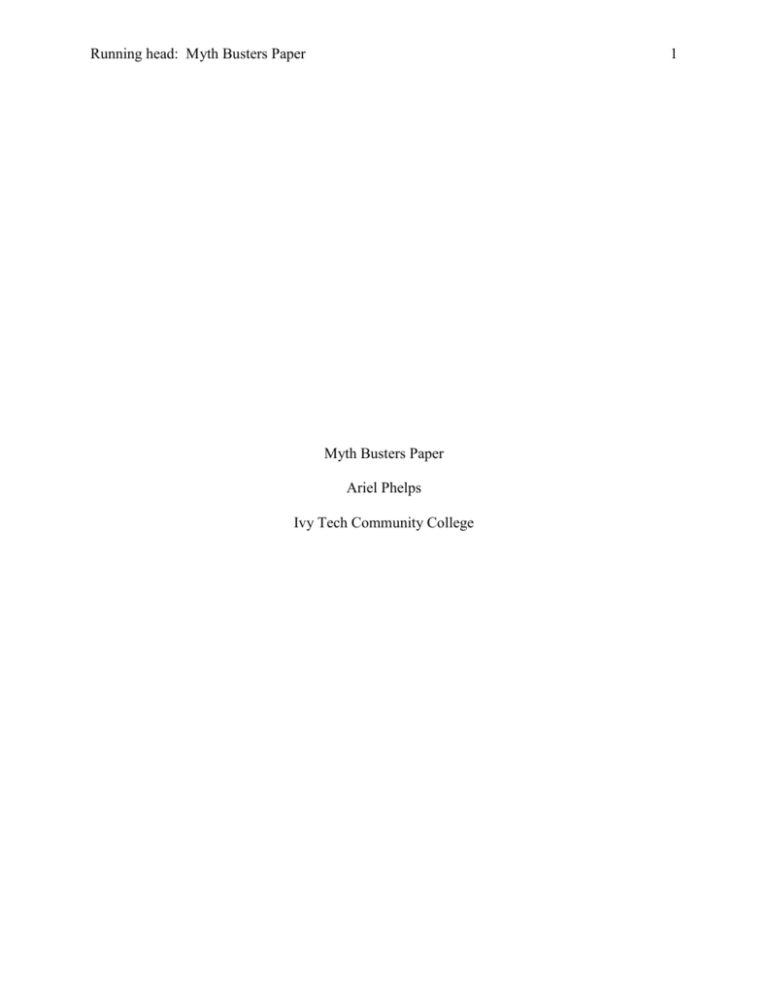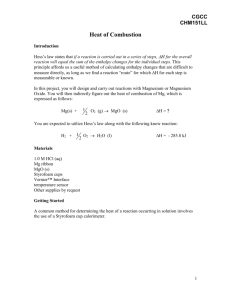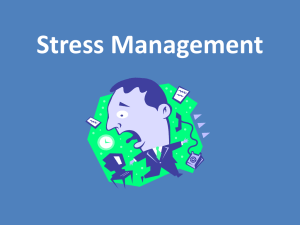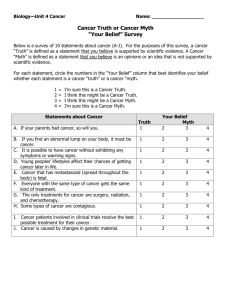Mythbusters - Ariel Phelps`
advertisement

Running head: Myth Busters Paper 1 Myth Busters Paper Ariel Phelps Ivy Tech Community College Myth Busters Paper 2 Can an object thrown from a quickly moving car, possibly kill someone driving another car? When some objects come to mind: a brick, a rock, anything with a large mass, this question is easily answered; yes it could kill someone. However, when the object is a Styrofoam cup filled with a mixture of drink, is this question as easily answered? This particular question was posed to Myth Busters who then tried to prove if it was true or not. After realizing Myth Busters is not currently airing new shows, it was difficult for me to find an episode I was interested in. The episode, “Lethal Littering” caught my eye because I see people littering all the time as I drive and it made me curious if I could possibly be killed because of someone’s trash. This episode was originally aired on March 24, 2010 on the Discovery channel. To prove if someone could be killed by littering, the Myth Busters team devised an experiment to test this theory. Jamie Hyneman, a host, suggested they have two cars driving towards each other, on different sides of the road, and one throws a Styrofoam cup filled with a drink at the other car’s windshield and the results are recorded. After Jamie stated this possible experiment, Adam Savage another host, agreed with this experiment but also stated they needed to figure out what type of drink would be the deadliest. To find this out, Adam proposed taking different drink concoctions and shooting them out of an air cannon and measuring the force each produced. To test the drink concoctions force, Jamie and Adam constructed an air cannon to shoot the drinks at a target. The target was a Load Cell but because the Load Cell was too small, it was sandwiched between two hinged steel plates. When the cup hit the first steel plate the Load Cell would pick up the impact and be able to measure the force. Adam came up with three different drink concoctions to test which was the deadliest. Before shooting each cup filled with a Myth Busters Paper 3 different substance, the cups were weighed. The first tested was a large Styrofoam cup filled with just soda. Its weight was 632 grams. The cup was then wrapped in a layer of plastic, to keep the cup and contents intact, and loaded into the air cannon. It was then fired at the target and the force of the impact was measured. The result was 3668 pounds of force. The second drink concoction was also put into the same type and size of Styrofoam cup, filled with soda and ice, and wrapped in plastic. Like the first drink, the cup was weighed and resulted in 649 grams. At this point Jamie realized he would have to make adjustments on how to load the cannon, since each cup had a different weight. He wanted the cups to have the same rate of speed when hitting the targeted Load Cell. After making the required adjustments Jamie loaded the cannon with the second filled cup. The result was 4331 pounds of force. The last large Styrofoam cup was filled with a Slushy mixture tinted blue and wrapped in plastic like the other cups. The filled cup was weighed resulting in 683 grams, making this the heaviest concoction and resulting in the most force upon impact. The ending result was 4386 pounds of force. With this part of the experiment concluded the Myth Busters knew the deadliest filled cup would be the Slushy mixture, resulting in it being the one thrown from a car at another car’s windshield. After gathering this information the Myth Busters started work on modifying the cars. Jamie mounted a steel frame on the passenger side of a truck, complete with a seat for the test dummy, Buster. He also added the frame work for a windshield that could be easily removed and a new one put in. While Jamie was working on the framework, Adam was painting Buster the dummy a lovely red color and putting sensor stickers on strategic points; the head and along the chest area. The stickers were used to see what kind of damage Buster would sustain upon impact. Myth Busters Paper 4 With Jamie driving the modified truck and Adam hanging out the passenger window of the car, the testing began. The first attempt with both cars driving 40 mph and Adam throwing a large Styrofoam cup filled with Slushy at the windshield resulted in a spider-web crack in the corner of the windshield. After the first attempt, the windshield had to be replaced with a new one, and the experiment was tested again. The second attempt required the Myth Busters to increase the speed of the vehicles to 60 mph, a more reasonable highway speed. Again Adam through a large Styrofoam cup filled with Slushy at the windshield as the cars drove by each other. This resulted in the windshield shattering and collapsing, but Buster was okay, no stickers were activated indicating injuries. For the third attempt the Myth Busters replaced the broken windshield and duct taped it into place, so it would not cave in like the one in the second attempt. This time the Styrofoam cup penetrated the windshield but was pulverized resulting in Buster being showered in blue Slushy but unharmed. They tried a fourth attempt resulting in a crack in the corner of the windshield but still no real damage to Buster. After these four attempts, Jamie and Adam came to the conclusions that a Styrofoam cup filled with a drink will not kill you if thrown out the window at highway speeds. Since the cup with blue Slushy failed to harm Buster, Adam and Jamie decided to try a full soda can. Again Jamie drove the modified truck while Adam threw the full soda can at the windshield. However, he was not very accurate and kept missing the windshield or hitting just the side. As a result of this Jamie constructed a soda can launcher/ “pop gun” to help with the accuracy. For this attempt Jamie and Adam traded seats, Adam driving the truck and Jamie launching the full soda can using the “pop gun” (Hyneman, 2010). This attempt yielded the same results as the cup filled with Slushy had. It damaged the glass of the windshield but caused Myth Busters Paper 5 no harm to Buster. The only way Buster was ever harmed was when Jamie shot the “pop gun” with a filled soda can at the windshield at point blank range, causing the can to break through the windshield and kill Buster. Based upon their process, to me this is scientific inquiry. Scientific inquiry is asking a question that leads to another question that leads to yet another question. This process can be interwoven and multileveled. The route may be circuitous and a long drawn out process, but in the end the question and more will be answered. The two main science concepts presented during this episode of Myth Busters was force and energy. After watching this episode I better understand the meaning of force. To me force is how much impact an object has on another object. Adam explained this concept when he sandwiched the Load Cell between two steel plates and shot the drink concoctions at the plates. The term energy when used during the episode confused me. I know energy is required to move objects but I do not understand how energy effects force. The Myth Busters kept using this term but never really explained it, making me curious and wonder what it means. This episode of Myth Busters left me with many questions, which is a good thing. The first is what exactly is energy and how does it affect force? My second question is if they would have used a cup made out of different material, such as plastic or paper, would it have been deadlier? To answer my first question I sought out my father’s help. My father is an electrical engineer and deals with energy every day. According to him (Phelps, 2013), “energy is movement or how fast something is going, this formula is how to determine how much energy is used .” After giving him a deer caught in headlights look, he re-explained it differently. “Everything exerts energy, even when something is not moving it still has energy just very little.” (Phelps, 2013) Myth Busters Paper 6 I spent many hours searching the web looking for the answer to my second question. However, I was not able to come to a definitive answer. According to a website, “Styrofoam and plastic cups are made from the same material.” ("Polystyrene," 2003). This makes sense because they are both made from a form of plastic, but I know from past experience that I can poke a hole in a Styrofoam cup with my finger, but I am not able to in a plastic cup. This makes me think that the plastic cup would hold up better on impact and possibly cause more damage when being thrown from a moving car than a Styrofoam cup would. I found this episode of Myth Busters interesting because I travel the highway to get to school most days of the week and see people throwing stuff out their windows all the time. Up until now it just upset me environmentally but now I wonder if I could possibly be harmed or have a wreck because of someone’s trash. I know I will never throw trash out my window and I will be more aware of my surroundings while driving. Myth Busters Paper 7 REFERENCES Hyneman, J. (Performer) (2010). Lethal littering [Television series episode]. In Myth Busters. Discovery Channel. Phelps, A. (2013, February 08). Interview by A.R. Phelps [Personal Interview]. Polystyrene. (2003). Retrieved from http://pslc.ws/macrog/kidsmac/polysty.htm.









